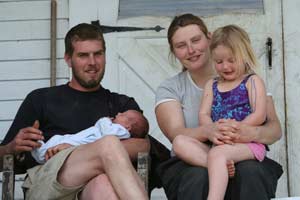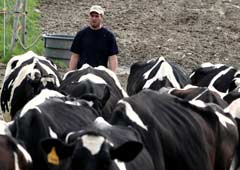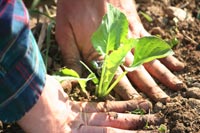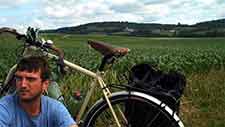Skowhegan, Maine. When I arrived at Grassland Organic Farm, I found an old and white weathered farmhouse. From a distance I witnessed a hand painted sign propped up against the front porch and in the shape of a milk jug. The sign was written in bold black lettering and read: “MILK: Organic. Fresh. Raw”. When I approached the house closely I found a hand written note taped to the door that was addressed to me. It read: “Nathan, We are working out in the garden about a half a mile from the house. Follow the road that leads straight back until you find us through the first tree line”.
I had just finished biking 30 miles in the hot summer sun and so I decided it was appropriate to take a quick rest on the dilapidated porch and admire the lush pastures speckled with beautiful dandelions that swayed gently in the cool breeze. Moments later a pickup truck zoomed up the steep and rocky drive, leaving a cloud of dust in its trail. Out stepped a tall, rugged and younger man who wore the farmers’ requisite dirty and beat up baseball cap. With a firm handshake and a direct look into the eye, the young man introduced himself as Garin Smith.
Initially it was awkward greeting and I found Garin to be weary of my presence and borderline standoffish. When I mentioned the possibility of an overnight stay he replied “We might be able to figure something out” quickly followed by “Did you bring a tent?” I couldn’t blame Garin for his cynical status. After all, I was a complete stranger who had contacted his wife Sarah through the Eat Well Guide (a free, online directory of family farms, restaurants, food co –ops and farmers markets) and asked if I could come to their farm via bicycle, snap photos and ask questions.
Grassland Farm is owned and operated by Garin and Sarah Smith, a young farming family in their mid-20’s. The farm functions primarily as an organic dairy farm where they milk 45 cows from a variety of breeds. They sell certified organic, grass-fed beef, pastured poultry and grow a wide variety of fresh vegetables from a well-established garden in order to combat the economic woes of the dairy industry and build biodiversity within their soils. In addition, Garin and Sarah have singlehandedly transitioned the Skowhegan Farmers Market from what was once consisted of just a handful of farmers and hardly any customers to a thriving and vibrant New England farmers market chalk full of small farmers and a steady flow of happy customers.
When Garin and Sarah assumed the risk of taking over Sarah’s father’s farm it was a far cry from a romantic farming novel. The dairy wasn’t making any money, tractors and the equipment were in bad shape and the herd was faced with health issues that stood in the way of productivity. Garin intensely recalled handling the death of cows early on as a result of poor health: “When I first came here the cows were not in very good shape. I had a situation where I would ask myself: ‘What would my customer want me to do with this cow?’ She is going to lay here, suffer and die or I can shoot her right now and it will be over with. Those were not pleasant decisions to make”.
This challenging environment forced Garin and Sarah to find a creative spark and in order to survive on the farm they decided to transition the farm to organic production and diversify. With a big smile Garin reminisced about one of his neighbors told him he wouldn’t make it more than a year or two. “We are still here”. – Garin said with a big smile. He attributes healthy cows, diversification, controlling their input costs and loyal customers to their recent success.
It didn’t take me long until I realized that things were busy on Grassland Farm. I had arrived in early May, so there was no livestock on the fields, but the preparations for their 2 acres of vegetables, a full production dairy and caring for the two young children kept Garin and Sarah busy. Garin made it politely clear that there was work to be done all the way around and that he would soon be bringing the cows into the barn for the evening milking session. Loosely translated: “Look buddy, if you are here to ask me a bunch of questions, that is as a good a time as any”. I nodded and watched Garin as he slowly walked out onto the pasture, positioned himself to the rear of his herd and with no physical effort whatsoever, he marched his cows into an old barn.
I spent the next two hours watching Garin move from cow to cow as he knelt down on the hard and dirty concrete floor of his tie stall barn. His obvious task was to extract milk from the udders of his cows using a suction device leading to a stainless steel bulk tank. The bulk tank is kept in the milk house where the milk is then cooled to roughly 35 degrees. Every other day a large milk truck arrives to pick up milk from a handful of farmers within the region. In the case of Grassland Organic Farm, the lucky recipient of this fresh milk is the farmer owned cooperative Organic Valley, based in LaFarge, Wisconsin, where I would find myself a few months later.
Garin had a knack for talking and milking at the same time. As he continued on with his milking session his voice softened and he suddenly became eager to share personal stories and engage in conversation. When it came to farming Garin had far more to offer in terms of noteworthy dialogue than I. However, he never made me feel out of place or naive when I began asking mundane questions about the dairy production. For example; during my wandering around the barn full of cobwebs and cow crap I noticed that every single one of Garin’s cows had a name on an ear tag. When I mentioned of this to Garin, he gave me a smile filled with endearment. Garin explained that he uses the first letter of the mother cow’s name to create a name for her calves. For example, if Mandy gave birth to a female calf it would be entered into the system as Mallory or Michelle.
Garin made no bones about his pride when it came to the health of his dairy herd. When I asked how he was able to keep his cows clean and healthy he said “We don’t like to push our cows too hard. Some of the larger farms push their cows a bit too hard early on. After about 4 lactations the cows are considered nonproductive and they get turned into burgers at McDonald’s” – “I don’t like to talk down on conventional farmers. They are good people and they have good values. It’s not that they don’t care about people’s health or the health of their animals; it’s just that they have been marketed to by the food corporations and many of them have bought in. So now they have tremendous overhead, a ton of debt and are forced to produce more and more of their products”.
Garin’s goals for the farm were clear and concise. Grassland was not to function as a stand-alone dairy farm. The plan was to utilize the dairy to supplement and support the other enterprises on the farm financially and bio dynamically. In simple terms; the manure from the cows would be used to enhance fertilization in the garden and build healthier soils for the pasture-raised beef and poultry. The laying hens would reside in a chicken tractor and follow the dairy herd around the fields and used intensively for pest control, in return keeping the cows healthier and more productive. When I marveled at Garin’s symbiotic and sustainable farming vision Garin said “I believe that we are on the verge of watching 25% of the dairy industry disappear and the more this economy becomes unstable, the more this method of organic farming will be more viable. If people aren’t paying anything for milk then we will add more chickens and put in some extra vegetables.
Out of nowhere and into the barn walked young Cedar Smith: She was maybe 4 or 5 years old and displayed a brilliant head of blonde hair with an enormous childlike smile. To my surprise she was extremely confident in her surroundings which consisted of large livestock, projectile urine and cow pies. In a very cute, yet stern voice, she informed Garin and I that it was time for dinner. Garin gently nodded and told the young girl that we would be in to join them shortly. In a roundabout way, I felt bad, because more than likely, Garin would have been done milking the cows much earlier and could have been on time for his meal with his family if it hadn’t been for me asking so many questions. When I made mention of my interruption he pulled the suction hose away from the udders of a cow and calmly said, “Don’t worry about it. If it’s not one thing it’s another. I don’t eat until these cows eat”. With that comment I no longer envisioned Garin’s herd as a unit that produced milk. I quickly came full circle with the notion that Garin’s cows were undoubtedly an extension of his immediate family.
The milking chores done, it was now time for dinner. Garin and I walked into the house where Sarah ran a tight ship getting the children fed and ready for bed. I was impressed with her immediately as she managed to answer several phone calls, keep young Cedar calm and prevent their new born baby from crying. All of this was done while preparing for the next big day of farming. Garin sat across from me in the kitchen and ate quickly, proving that he had worked up a large appetite from his nonstop work in the barn. I joined Garin and we commenced our hunger attack. After dinner we shared a few laughs in between fits of yawning before we mutually expressed the desire for sleep. I proceeded to a dusty and dark spare bedroom above the workshop where a window above my head would provide access to an evening sky full of stars that put me to rest.
The next morning I was the last one awake. Normally, I would have felt a bit like a slacker, but given the fact that I was in competition with a dairy farmer and the mother of a new born child, the odds that I was going to be the first one “up and at `em” were certainly stacked against me. I walked into the kitchen where I found Sarah breastfeeding their baby as she gave instructions to Jo (the farming apprentice) – Jo had natural blonde hair, a stocky build and when she smiled her mouth revealed a tooth that was peculiar and resembled a fang. She wore a black tank top covered by a tattered flannel shirt, a pair of pants you would find on an elderly woman cut with scissors about mid-calf and walked mostly in bare feet. Sarah gave her a specific list of chores that included, planting, tilling and hoeing.
I decided to join both Sarah and Jo in the garden and gather a few photographs. I was in awe when I witnessed Sarah working away in the hot sun, knowing that she had given birth less than two weeks prior to my arrival. Like my Grandmother, who gave birth to 11 children and claims more than 30 grandchildren, Sarah showed no signs of slowing down and maternity leave was not an option. I realized quickly that family farming was a far different commitment and occupation from those I knew back in Southern California. There were no two weeks of paid vacation and obviously there was no maternity leave either. This was farming.
Before the evening chores were ready to begin I asked Garin and Sarah if they could make time to sit down with me as a family and answer a few questions. Sarah welcomed the possibility with great enthusiasm and Garin glanced over a long mental list of to-do’s and said “If we are going to do it, we better do it now”.
The interview decided, the entire Smith family and I walked to the front of the old farm house where I had first arrived. As I sat facing the entire Smith family, I was struck by the beauty and the authenticity of my surroundings: it was the weathered farm house in the background, Garin’s dirty cap displaying countless hours of hard work and Sarah gently rocking her newborn to sleep that made everything feel so real and so perfect.
As the interview started I asked the Smith’s how the recent economic collapse was affecting their farm. “The Recession has impacted a lot of farmers. For us, we are lucky. It has impacted our milk prices, but we are still growing. As far as I can tell, people are still willing to support farmers in these tight times”. To underscore the power of buying local and buying organic, Garin continued by saying, “That is the value that comes with establishing a relationship with your customers. They will still support you even when they themselves do not have a lot of money”.
I followed up by asking Garin a question that I would ask a countless people on this journey. “What is your message to America?” He replied “These days we are talking about reforming the health care system here in America. How about we start with making healthy food available for people? We should take a preventive approach to medicine. If we give people healthy food we will see fewer health issues. I have seen it work on a small scale, so I don’t see any reason as to why it couldn’t work on a large scale”. “Conventional agriculture isn’t oblivious to this. They just have a different way of doing things”. “I think people should value a farmer in the same way they would value a doctor and consider us to be providers of health”. “We’re not over here investing in the stock market or downstairs throwing money in a hidden box. If people looked at how much we work and how much money we actually made, they would say ‘Gosh, why would you do that’?'”
As the conversation came to an end, Sarah made a comment that would resonate with me throughout this entire journey. With great conviction she said “The reality of the situation is this: If everyone here in Skowhegan wanted to buy from us at the farmer’s market there wouldn’t be enough food to go around. We need to get more people to farm because farming is extremely empowering and in order to change our food system, we need to move towards a point where 1 in 3 people are growing food. Not 1 in a 1000. If people are concerned with where their food comes from, they should not only support their local farmers but they should simply grow their own food”.
Read the Unconventional Harvest series:
- On the Road to Find the Future of Food and Farming
- Grassland Organic Farm
- Wellspring Farm
- My Visit to an Amish Farm in New York
- Farm Sanctuary
- An Urban Oasis for Food
- Tantré Farm
- Conventional Dairy Farmer Art Thelen
- New Forest Farm
- A Large No-Till Organic Farm
- Melstone, Montana—Population 136
- In the Farmers Own Words
Nathan Winters rode a bicycle across America to discover first-hand why our food system had grown to be unsustainable, and to find alternative solutions. He traveled into the homes and communities of organic, conventional, urban and Amish farmers and community organizers. This ongoing series—to be posted every other Wednesday— represents select material from The Unconventional Harvest, a work in progress, by Nathan A. Winters.




